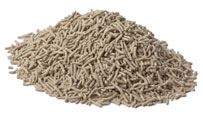Bactimos PT

Bactimos PT is a high-potency (800 International Toxin Units [ITU] per milligram) pellet formulation of Bacillus thuringiensis subsp. israelensis (Bti, strain AM65-52) designed specifically to target nuisance populations of non-biting midges (Chironomidae). Bactimos PT is designed to sink immediately upon application to assure accurate application of the product to the sites where larval populations develop.
Bactimos PT should be applied uniformly over the entire surface of the lake or pond. In large habitats where complete surface treatments are not possible, applications concentrated along the perimeter may be effective in reducing localized midge populations. Larval sampling in some habitats has indicated that significant larval populations occur within 3–4 meters of the pond perimeter in 1-meter-deep water.

However, before pursuing perimeter applications, one should confirm larval distribution with the site. Only a small percentage of the thousands of pestiferous species of “non-biting midges” have been tested for susceptibility to Bactimos PT. Members of the subfamilies Chironomini and Tanytarsini are generally susceptible; members of the subfamily Tanypodinae are not susceptible at the Bactimos PT labeled-use rate. When initially using Bactimos PT in a midge-control program, it is recommended that only a small test area be treated if the species of midge(s) to be controlled has not been identified.
Suggested Rate Range:
Apply 22–27 lbs/acre (25–30 kg/ha) through conventional ground equipment to typical midge habitats such as man-made/natural lakes, ponds, lagoons, sewage oxidation ponds, channels, and ditches used for industrial discharge.
Use higher rates in deeper water ≥ 20 inches (0.5m). Repeat applications as needed after 2–3 weeks. Control of midges may be gradual over a period of 2 weeks.
It is generally agreed that sediment characteristics and water depth are common influences on chironomid assemblages. Larvae of most chironomid species of economic importance in the U.S. typically occur in shallower sand substrates; therefore, sampling and control efforts should be concentrated in these areas.
Susceptibility of Midges to Bactimos PT
Chironomid larvae are typically 15–75 times less sensitive than some mosquito larvae to Bti; consequently, much higher rates are required to manage chironomids. It is assumed that the near-neutral gut pH in many chironomid larvae is the reason for the lower susceptibility of chironomid larvae to Bti-toxic proteins than other nematoceran Diptera, specifically mosquitoes. In two pestiferous Florida chironomid species, gut pH levels of 6.7–7.6 units were found compared to up to 11 pH units for mosquitoes. Alkaline pH conditions are usually necessary for activation of spores and the solubilization of Bti-toxic protein crystals.
Resources
Learn more about Bactimos®
Quick Links
Contact a Valent BioSciences public health representative.
Contact Us






